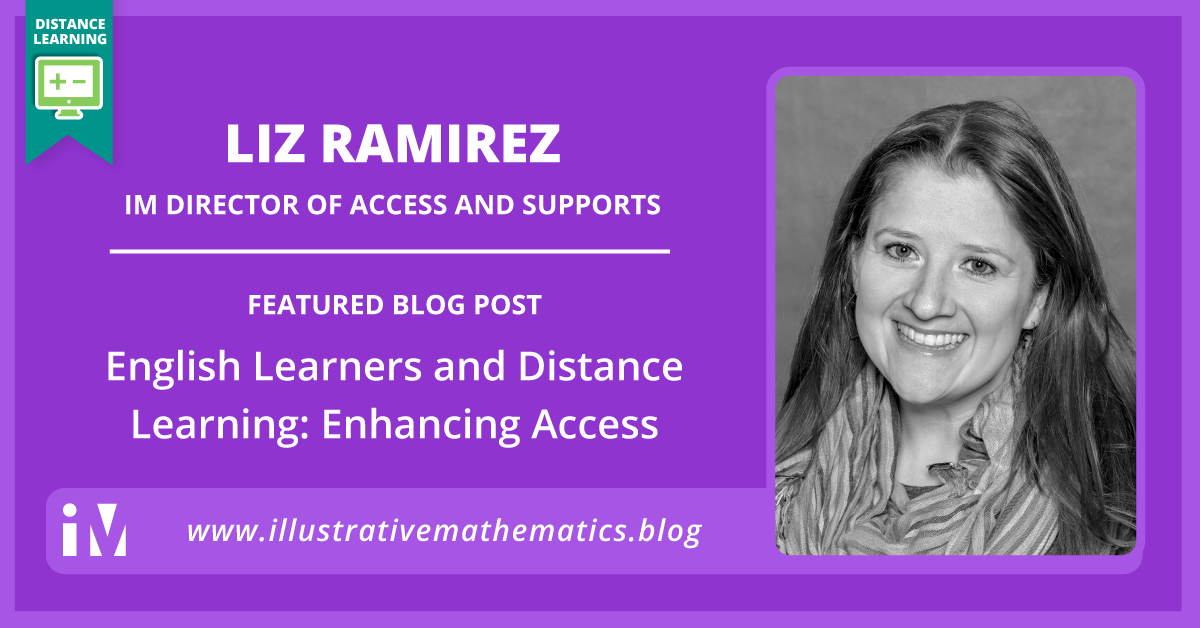By Liz Ramirez
Which students are experiencing success in today’s “distance learning”? What barriers do other students face?
While virtual learning platforms have made it possible for some live instruction to continue during school closures, this type of learning environment presents additional challenges for students who are learning English. Many of the language supports and resources that students rely on in the classroom are no longer accessible, including subtle ones like teacher gestures, word walls, and turning to a partner for clarification. Now…?
How do we support English learners in a virtual learning environment?
Coming up in this series of posts, we’ll look at some examples of ways to use Math Language Routines (MLRs), during distance learning, in both synchronous and asynchronous learning environments, to “strengthen the opportunities and supports for helping students to describe clearly their mathematical thinking to others, orally, visually, and in writing.”1
Here are some quick tips and practices for instruction in a virtual learning environment that help to enhance access for English learners.
It’s important to create an environment that supports receptive language functions. This includes listening, reading, and representing ideas.
Listening:
- Mute all microphones, except for the person who is speaking to limit extraneous noise.
- Read all prompts, questions, directions, and slide contents aloud.
- Remind all speakers to speak clearly and slowly. It’s easy not to notice how fast you are talking, especially when you can’t see the faces of the people you are speaking to.
- Encourage students to ask questions and press each other for details to support their own understanding.
- Repeat important information, directions, vocabulary and questions multiple times.
- Embrace independent think time. Give students time to make sense of what they are being asked to do, time to do it, and time to figure out how to communicate what they are thinking.
Reading/Representing
- Maximize the use of visuals: use screen sharing to view slides, documents, worksheets, etc.
- Provide students with access to slides and other resources. Students may benefit from the opportunity to preview content when possible, or will benefit from being able to refer to the materials after a lesson.
- Use live annotation to help make student thinking visible.
- If possible, record sessions and make them available to students to rewatch at a later time.
You will also want to provide multiple opportunities for students to produce verbal and written language, through speaking, conversing, and writing.
Speaking/Conversing:
- Revoice or restate student thinking.
- Tip: Hold students accountable to listening to each other. Call on students to restate what they hear, either verbally or in the chat.
- Use choral repetition of new or important words and phrases to give all students an opportunity to practice and produce language.
- Use multiple or “breakout” rooms for small group conversations. Be sure that all students understand the prompt, how much time they have, and what they will be expected to report back on when they return.
Writing:
- Provide multiple means of participation: Invite students to share ideas and ask questions in the chat window. This strategy allows for multiple students to share a response and to produce language at the same time.
- Tip: Give students explicit instructions for when to type and when to share to help preserve think time.
- Tip: Direct students’ focus to the chat window at strategic times. It’s difficult to pay attention to multiple things going on at once.
One last suggestion is to invite students to talk about and solve problems with their families. Check out IM Talking Math 6–8 for weekly open-ended prompts that invite math conversation. These weekly prompts are also available in Spanish.
Next Steps
We would love to learn alongside you. What strategies, tools or resources have helped you support access for your English learners? Share your ideas at #LearnWithIM.
Also: watch out for the rest of the blog series on English learners and distance learning environments, published every Tuesday for the next few weeks.
__
1Zwiers, J., Dieckmann, J., Rutherford-Quach, S., Daro, V., Skarin, R., Weiss, S., & Malamut, J. (2017). Principles for the design of mathematics curricula: Promoting language and content development. Retrieved from Stanford University, UL/SCALE website: https://ell.stanford.edu/content/mathematics-resources-additional-resources
